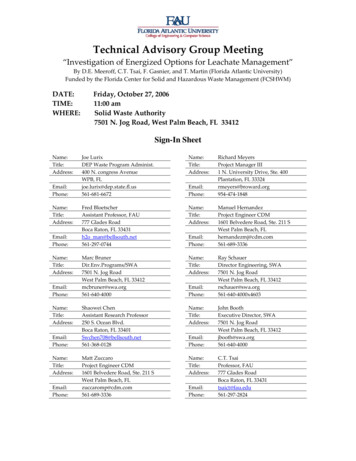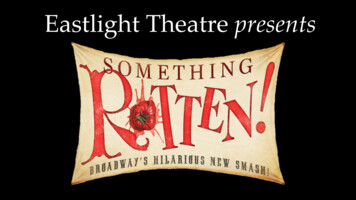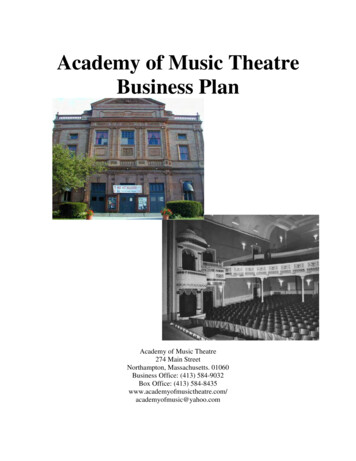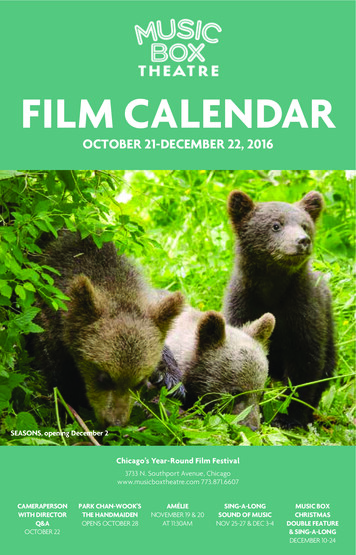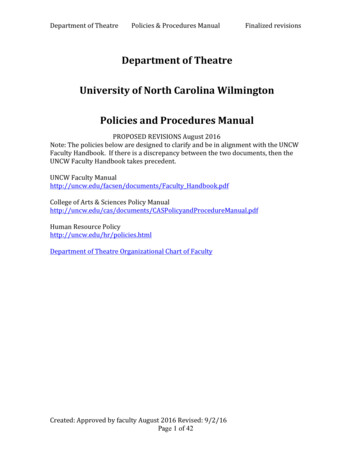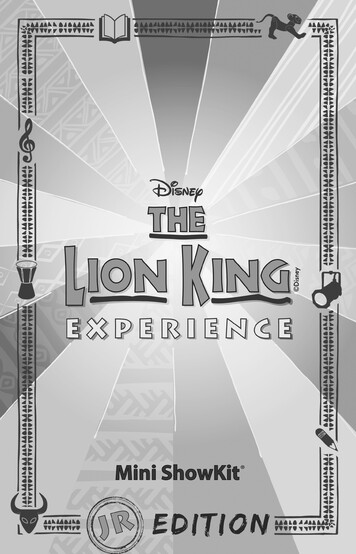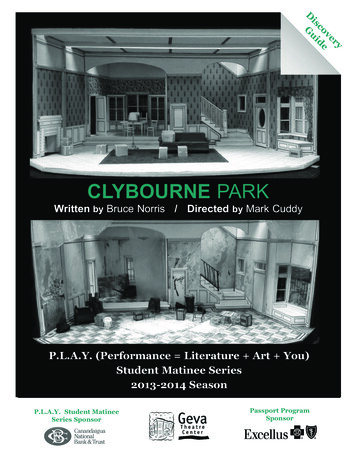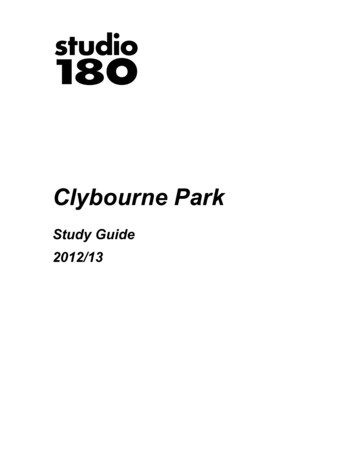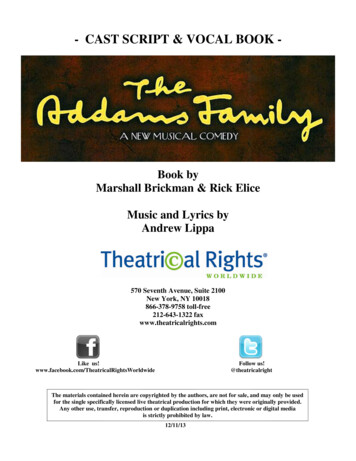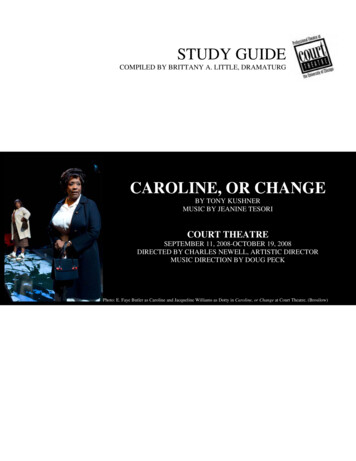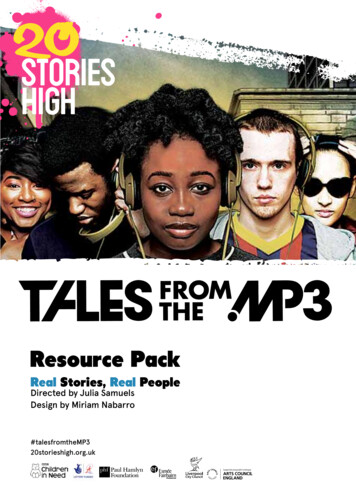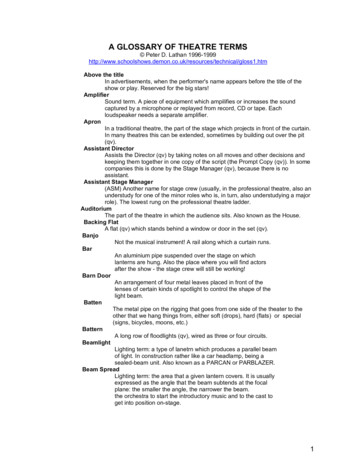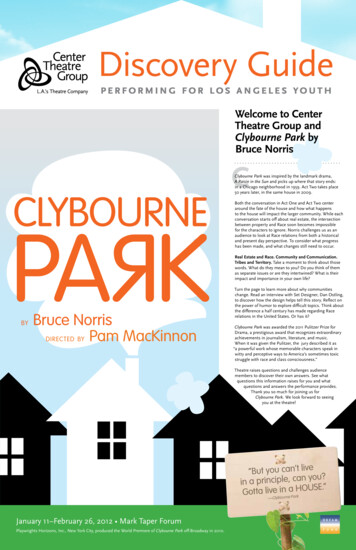
Transcription
Discovery GuideWelcome to CenterTheatre Group andClybourne Park byBruce NorrisCClybourne Park was inspired by the landmark drama,A Raisin in the Sun and picks up where that story ends:in a Chicago neighborhood in 1959. Act Two takes place50 years later, in the same house in 2009.Both the conversation in Act One and Act Two centeraround the fate of the house and how what happensto the house will impact the larger community. While eachconversation starts off about real estate, the intersectionbetween property and Race soon becomes impossiblefor the characters to ignore. Norris challenges us as anaudience to look at Race relations from both a historicaland present day perspective. To consider what progresshas been made, and what changes still need to occur.Real Estate and Race. Community and Communication.Tribes and Territory. Take a moment to think about thosewords. What do they mean to you? Do you think of themas separate issues or are they intertwined? What is theirimpact and importance in your own life?byBruce Norrisdirected by Pam MacKinnonTurn the page to learn more about why communitieschange. Read an interview with Set Designer, Dan Ostling,to discover how the design helps tell this story. Reflect onthe power of humor to explore difficult topics. Think aboutthe difference a half century has made regarding Racerelations in the United States. Or has it?Clybourne Park was awarded the 2011 Pulitzer Prize forDrama, a prestigious award that recognizes extraordinaryachievements in journalism, literature, and music.When it was given the Pulitzer, the jury described it as“a powerful work whose memorable characters speak inwitty and perceptive ways to America’s sometimes toxicstruggle with race and class consciousness.”Theatre raises questions and challenges audiencemembers to discover their own answers. See whatquestions this information raises for you and whatquestions and answers the performance provides.Thank you so much for joining us forClybourne Park. We look forward to seeingyou at the theatre!“But you can’t liveyou?in a principle, cana house.”Gotta live inourne Park— ClybJanuary 11–February 26, 2012 Mark Taper ForumPlaywrights Horizons, Inc., New York City, produced the World Premiere of Clybourne Park off-Broadway in 2010.
insideClybourne Park Act 1Clybourne Park Act 2Communities ChangeThe Limits ofCommunicationA Conversation withDaniel OstlingCredits601 West Temple StreetLos Angeles, CA 90012Education andCommunity ce Services213.628.2772CenterTheatreGroup.orgTheatre LocationsMark Taper ForumAhmanson Theatreat the Music Center135 North Grand AvenueLos Angeles, CA 90012Kirk Douglas Theatrein downtown Culver City9820 Washington Blvd.Culver City, CA 90232234678ACT IWriterRonald McCantsGraphic DesignerNishita DoshiAssociate Director of Educationand Community PartnershipsDebra PiverPerforming for Los Angeles Youth(P.L.A.Y.)Project FacultyLynn ClarkLeslie IshiiMarcos NajeraMichael YurchakBernard AddisonEducational Programs AssociateCarla CoronaEducational CommunicationsCoordinatorKelly ChristInspired byA Raisin in the SunLorraine Hansberry read and was deeply moved by Langston Hughes’poem Harlem, which asks “What happens to a dream deferred?” She wroteA Raisin in the Sun as an attempt to answer this very question and choseto end the play with a sense of hope. Although the struggle continues, theYounger families’ dream of owning a home is no longer deferred. Otherartists have seen A Raisin in the Sun and been moved to respond with theirown artistic expression. Clybourne Park is one of these responses.At the end of A Raisin in the Sun, the Younger Family is moving from aBlack ghetto to a house in the all White neighborhood of Clybourne Park.They will be the first family to cross the color line in that neighborhood.While packing, they are approached by Karl Linder, a representative ofthe Clybourne Park Neighborhood Association. Karl offers the Youngersa competitive counter-offer to not move into the house. The Youngersdecline his offer, even though Karl warns them about possible violencefrom their neighbors.Bruce Norris was intrigued by Karl Linder. He took the character fromA Raisin in the Sun and expanded his role; imagining what Lindner mightdo next to prevent the Youngers from moving into his neighborhood. Hegot curious about the White family that was selling their home in ClybournePark and re-imagined the play from their perspective. Who were they? Whywere they selling their house? What was happening on the other side oftown from the Younger family in 1959?And what would be happening in that same neighborhood fifty years later?ProofreaderJanine Salinasfifty years pass and in 2009, Clybourne Park is a radically different neighborhood.It has become a primarily Black community on the verge of gentrification. We meet Lindseyand Steve, who are purchasing the same house that Bev and Russ sold in 1959. The house hasdeteriorated during these 50 years and Lindsey and Steve plan on demolishing it and rebuildinga larger and more modern home. Lena, a relative of the Black family who purchased the homefrom Russ and Bev in 1959, doesn’t want the house to be demolished because it would destroy animportant part of the neighborhood’s history. Act Two begins with a meeting to discuss the house’sfuture. While the conversation begins with a discussion of renovation and property rights, it soondiverts to the sensitive topic of Race. The characters are unable to address Race directly and theconversation goes to unexpected places. It reveals the assumptions each of them have about othergroups of people and begs us to ask the question: how far have we come since 1959?Damon Gupton and Jeremy Shamos in the Playwrights Horizons production of Clybourne Park. photo by joan marcus.Has the situationc ha n g e d o r m erelythe conversation?Who’sWhoIn Clybourne Park, each actorplays two different characters.In Act One, we meet theactors as people living inAmerica in 1959. In Act Two,50 years have passed and eachactor plays a different person,living in 2009.How would you continue theconversation raised in Harlem, A Raisinin The Sun and Clybourne Park?What do you feel needs to be explored orexpressed about Race in America today?What form would you want to expressthis in? Music, poetry, activism, art, ortheatre?What do you imagine the neighborhoodof Clybourne Park will be like in 2059?What will the conversation be aboutthen?Why do you think that BruceNorris decided to haveactors play two differentroles? What was his intent?Russ,homeowner,married to BevBev,homeowner,married to RussDan, contractor,working on thehomeKathy, Lindseyand c workerin the home ofRuss and BevLena, long-timeneighborhoodresident and amember of theProperty Owner’sAssociationAlbert,married toFrancineKevin, marriedto LenaKarl, Russ andBev’s neighbor,represents theNeighborhoodAssociationFor some it is to express feelings, to share stories,to capture experiences. Some write to provoke,enlighten, heal, or ignite change.Playwrights write knowing their words will be sharedwith a live audience. Playwrights think about whatthey want their audience to feel, think or experienceas they hear the words of the play brought to life.r in makingewopisreeh“Tfortable.people uncomprovoking.”inrewopisreTh eisBetsy, marriedto KarlSteve, Lindsey’shusband, newowner of thehomepeople write for different reasons.— Bruce Norrl - r:Clybourne Park 2ACT IIbev and russ are moving out of their modest bungalow in Clybourne Park, anexclusively White neighborhood of Chicago,Illinois in 1959. Their primary reason for moving is toescape the constant reminders of their deceased son who was a Korean War veteran. Bev and Russfeel ostracized from their community and are selling their home at a deeply discounted rate. Theydo not know that their realtor sold the property to a Black family until their neighbor, Karl Linder, amember of the Clybourne Park Neighborhood Association, tells them. He urges Bev and Russ to notsell their house to the Black family for fear that if they do so, the property values will decrease andother White families will begin to leave the neighborhood. Despite threats and derision for their lackof concern for their fellow neighbors’ properties, Bev and Russ refuse to change their decision. Theyno longer feel loyalty to a community that they feel has betrayed them.often art is inspired by other art.Discovery Guide20091959Lindsey, Steve’swife, new ownerof the homeJim, Minister ofthe neighborhoodchurchTom, a lawyerrepresenting theProperty Owner’sAssociationAs you watch the play, noticewhat the actors do physically,vocally and emotionally tocreate two very differentpeople. What do thecostumes tell us abouteach character? How do thedifferent time periods impactthe choices the actors make?How does the choice to haveactors playing two roles,impact us as an audience?What is the power or purpose inmaking people uncomfortable?What is the power of provoking?Have you ever been in an uncomfortablesituation that gave you new insight orchanged your thinking in some way?How did the discomfort motivate you?What is the power in imaginingthe world the way you want it to be?How might art move our world forward?Do you believe, as Lorraine Hansberrydid, that without art, there might beno world?If you are a writer why do you write?What is your intent?“Write about theworld as it is andas you think itought to be—if there is to bea world.”— Lorraine Hansberry
“Communities change.”“Neighborhoodscan be communalplaces that supportthe members thatlive in it or they canbe tribal places thatattack outsiders orthey can be both.”—Bill Savage, Northwestern University English ProfessorNew ‘Clybourne Park’ Picks Up On 1959 Race Issues by Cheryl Corley,Copyright 2011 National Public Radio .neighborhoods change.Even if some people might like their community to remainthe same, the truth is that neighborhoods are often in flux.Many factors contribute to a community’s change includingchanging demographics (who lives there), changing industry(businesses shut down, other types of businesses open),a changing economic climate (property values go up ordown) and changing perceptions and emotions (how peoplefeel about a neighborhood and its desirability or safety.)Sometimes the change is welcomed and celebrated.Sometimes the change is frightening, and often the changecan make a community completely unrecognizable. Thereaction to change is highly personal and raises questions:What makes a house a home? What defines a neighborhood?What makes a neighborhood into a community?“The history of America is the history ofprivate property.”—Clybourne ParkProperty: that which a person owns;the possession or possessions of a particular ownerThe United States has very specific, legal definitions for various typesof property. These include:Public Property: property owned by a government; it commonly refersto parks, playgrounds, streets, sidewalks, schools, libraries, and otherproperties regularly used by the general public.Private Property: land or belongings owned by a person or group andkept for their exclusive use; land not owned by the government.Different types of private property include:Real Property: land and the improvements to it made by humaneffort (also known as “immovable property”).Personal Property: everything that is the subject of ownership thatdoes not come under the definition of real property (roughlyspeaking, it is private property that is moveable). It is divided intotwo major categories: Tangible Personal Property: refers to any type of propertythat can generally be moved, touched, or felt; includessuch items as furniture, clothing, jewelry, art, writing, orhousehold goods. Intangible Personal Property: this refers to personal propertythat cannot actually be moved, touched, or felt, but insteadrepresents something of value such as stocks, bonds, patents,and copyrights.Intellectual Property: property that results from original creativethought, such as patents, copyright material, and trademarks; it candescribe a wide variety of property created by musicians, authors,artists, and inventors.The conflicts that arise in Clybourne Park start with a dispute involving privateproperty, namely real property, also known as “real estate.”In the United States, when a person owns real estate, he/she holds a set of rightsthat enable him/her to utilize this land in ways that they see fit. However, theserights are not absolute. Our government also reserves certain rights associatedwith these lands because it has agreed to protect the property for the owner.Among the government’s rights is the right to control the use of private propertyto ensure the protection of the public’s interest.—Clybourne ParkCrossing the Color Line:“one of the most frequently used statementsregarding Race issues in America is that of W.E.B. Du Bois (1903),who observed that the most pressing problem facing America inthe twentieth century is that of the color line. This quote is so oftenrepeated because the problem of how we perceive, define andnegotiate race remains.” 1In 1959, conversations about Race often focused on neighborhoodintegration, specifically Black families moving into Whiteneighborhoods—crossing an invisible but very real color line. Wedon’t actually witness anyone crossing the color line in ClybournePark. A Raisin in the Sun ends with the Younger family’s decisionto move into an all White neighborhood despite having beenwarned of the dangers. In Clybourne Park, an unnamed Black family(presumably the Youngers) crosses the color line and moves intothe neighborhood between Act One and Act Two.To be the first Black family in a White neighborhood requires greatcourage. In 1937, playwright Lorraine Hansberry’s family moved tothe all White neighborhood of Washington Park, in Chicago, Illinois.White Flightthe first act of clybourne park illustratesthe beginning of White Flight. White Flight i
Clybourne Park was inspired by the landmark drama, A Raisin in the Sun and picks up where that story ends: in a Chicago neighborhood in 1959. Act two takes place 50 years later, in the same house in 2009. Both the conversation in Act One and Act two center around the fate of the house and how what happens to the house will impact the larger community. While each conversation starts off about .
